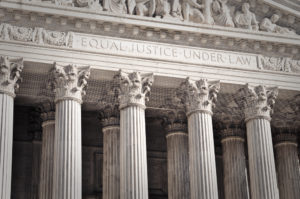Federal Criminal Appeals Lawyer call 1-800-APPEALS (1-800-277-3257)
US v Martinez
991 F.3d 347
Second Circuit Court of Appeals
Decided on March 16, 2021
Issue:
RICO Conviction and a ‘Crime of Violence’
Whether 1) defendant Martinez’s RICO conviction based on only one predicate crime of violence is a violent crime for the purposes of § 924(c) and 2) whether Martinez’s sentence of 240 months’ imprisonment was substantively unreasonable.
Holding:
RICO Conviction With Any Element of Violence Triggers § 924(c) Enhancement
The Second Circuit held that 1) a RICO conviction based on only one predicate crime of violence is a violent crime for the purposes of § 924(c) and 2) Martinez’s sentence was not unreasonable and not an abuse of discretion.
Federal Criminal Appeals Lawyer call 1-800-APPEALS (1-800-277-3257)
Facts:
Defendant Jose Antonio Martinez, along with other MS-13 gang members, traveled several times into rival gang territory searching for a man against whom Martinez had a grudge. When their search attempts proved unsuccessful, they decided to shoot at a group of men they believed to be members of Los Vatos Locos. The shots killed a man who was not affiliated with the rival gang, and Martinez later pled guilty to several RICO charges: conspiracy to commit murder for the purpose of maintaining and advancing his position in a racketeering enterprise in violation of 18 U.S.C. § 1959(a)(5), and possessing a firearm during a crime of violence during which the firearm was brandished and discharged in violation of 18 U.S.C. § 924(c)(1)(A). Martinez was sentenced to concurrent ten-year terms of imprisonment on the racketeering counts and a mandatory consecutive ten-year term on the firearms charge.
Martinez appealed, arguing that his 240 months’ imprisonment was substantively unreasonable due to his attempted cooperation with authorities, his personal circumstances, and the fact that he did not personally shoot Halley. Martinez later filed a supplemental brief arguing that the Supreme Court’s decisions in Johnson v. United States (576 U.S. 591, 135 S.Ct. 2551, 193 L.Ed2d 569 [2015]) and United States v. Davis (139 S.Ct. 2319, 204 L.Ed.2d 757 [2019]), and the Second Circuit’s decision in United States v. Ivezaj, 568 F.3d 88 (2d Cir. 2009), calls into question his § 924(c) conviction. Because he raised the § 924(c) argument for the first time on appeal, the Second Circuit examined the case under plain error review.
Analysis:
§ 924(c) Firearm Enhancement
As relevant here, § 924(c) provides an enhanced punishment for “any person who, during and in relation to any crime of violence…uses or carries a firearm.” (18 U.S.C. § 924(c)(1)(A). The enhancement requires a seven-year mandatory sentence if the firearm is brandished, and ten years if it is discharged.
Johnson and Davis Decisions
The Supreme Court held in Johnson that the “residual” clause of the Armed Career Criminal Act (ACCA), which similarly enhances punishment for possession of a firearm by a convicted felon who had multiple prior convictions for “violent felonies” defined as felonies that “involve conduct that presents a serious potential risk of physical injury to another” was unconstitutionally vague. This decision caused confusion in the courts of appeals as to whether the holding applied not only to statutes that required courts to characterize crimes of which a defendant had been previously convicted, but also to cases like this one involving § 924(c), where risk is assessed with respect to the offense charged.
Then came Davis, in which the Supreme Court invalidated the residual clause applicable to Martinez under § 924(c)(3)(B); thus Martinez’s underlying offenses cannot be found to be crimes of violence under that branch of the definition. Martinez therefore argued that these decisions call into question whether his convicted offense triggers §924(c)’s force clause, which requires that the conviction “ha[ve] as an element the use, attempted use, or threatened use of physical force against the person or property of another.”
United States v. Ivezaj and RICO Violations
In United States v. Ivezaj, the Second Circuit held that a RICO offense based on two violent racketeering predicates is a violent crime for the purposes of § 924(c). Martinez contended that because his RICO offense is predicated on only one violent act and two conspiracy acts, his offense does not trigger the § 924(c) enhancement. But the Second Circuit disagreed, explaining that the substantive RICO violation based on only one predicate crime of violence would be a crime of violence under § 924(c).
As the Government argued, it is not necessary for every element of the crime to involve violence, only one element of the crime must do so. Ivezaj suggests that in order to address substantive violations of RICO, one must “look to the predicate offenses to determine whether a crime of violence is charged.” (Ivezaj, 568 F.3d at 96). Following this logic, the Court explained that a RICO pattern consisting of a murder and a narcotics conspiracy requires a finding of the use of force against another just as that of a RICO pattern consisting of two murders. Martinez therefore failed to prove that the district court plainly erred in accepting his guilty plea to a violation of § 924(c) predicated on an admitted pattern of racketeering that includes a predicate violent crime.
Unreasonableness of Sentence
Martinez also argued that his 20-year sentence was unreasonable, but because the RICO pattern included a murder, punishable under New York State law by a maximum of life imprisonment, the RICO offense is similarly punishable by a maximum of life imprisonment. The sentencing guidelines calculated by the district court recommended a sentence between 292 and 364 months’ imprisonment, so the Second Circuit could not find that Martinez’s sentence of 240 months’ imprisonment was unreasonable or an abuse of discretion. The Second Circuit accordingly affirmed the judgment of the district court.





